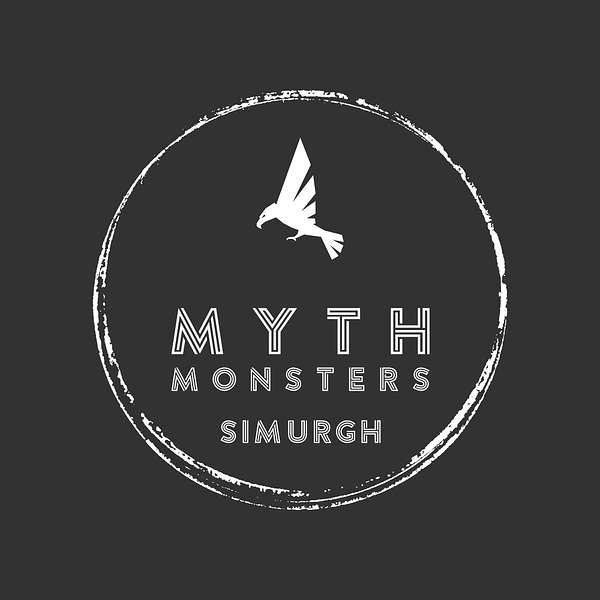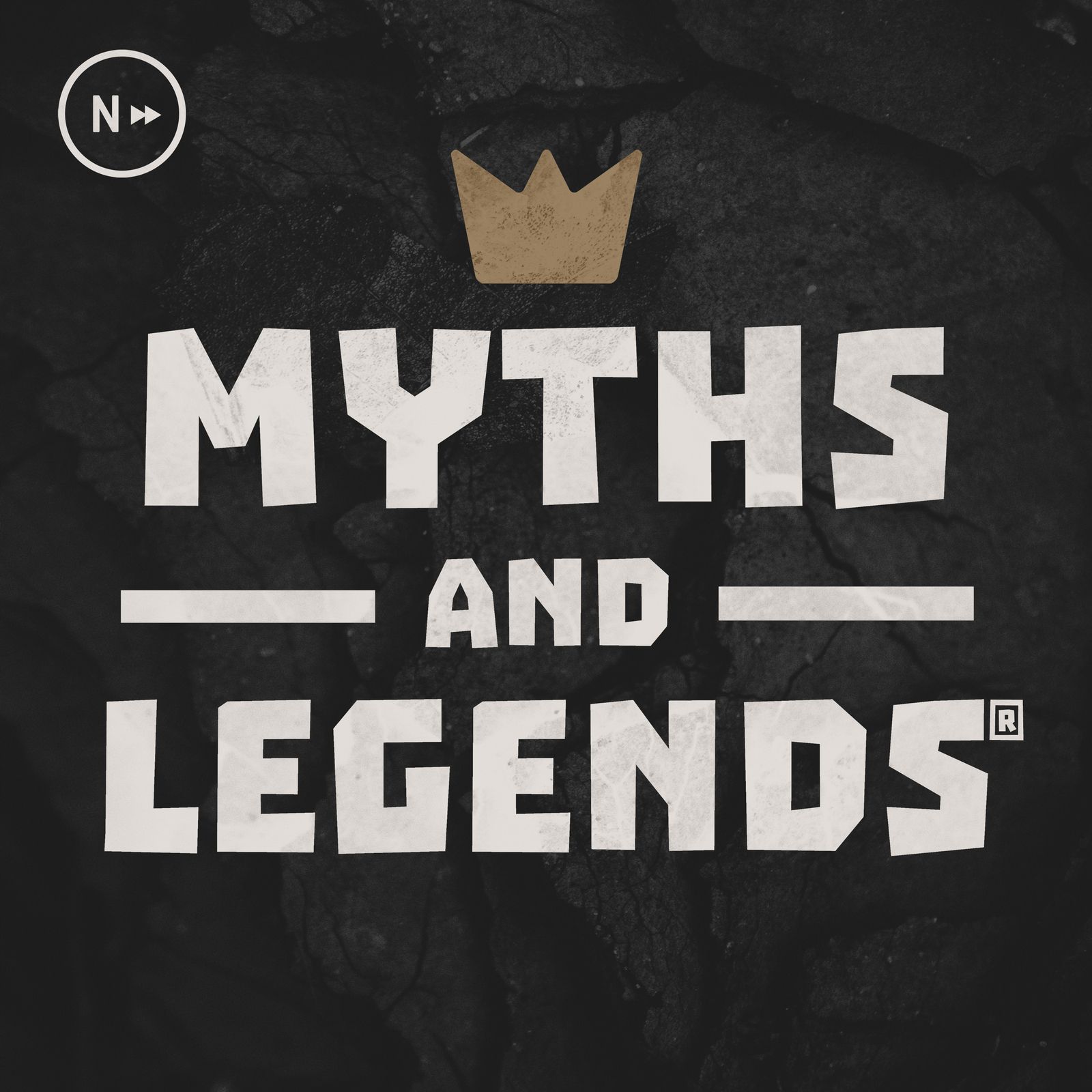
Myth Monsters
A bite sized look into the monsters of global folklore, cryptozoology and mythology with your host, Erin. Jump in and learn about your favourite monsters from Gorgons to Kelpies, to Wendigos to Bigfoot. Stay spooky every Thursday with a new episode with a new monster from another culture. Get in touch on Twitter at @mythmonsterspod
Myth Monsters
Simurgh
In this week's episode, we're heading over to Ancient Persia to look at another legendary bird - the Simurgh! How does this monster relate to the Greek Phoenix? How does it get its immortality? Find out this week!
You can find us on:
Social media:
INTRO:
Hello and welcome to Myth Monsters, my name is Erin and I’ll be your host for these little snack bite size podcasts on folklore and mythical monsters from around the world.
These podcasts focus on the actual cryptids, folklore and mythic monsters from global mythology, rather than focusing on full stories of heroes and their big adventures.
I’ll also be dropping in some references that they have to recent culture and where you can see these represented in modern day content so you can learn more, and get as obsessed as I am about these absolute legends of the mythological world.
We’re back to normal scheduling this week, but I hope you enjoyed the double feature last Thursday and Friday! I really enjoyed making them, and they were two great monsters, but so is this one!
DESCRIPTION:
We’re heading over to Ancient Persia this week for another mythical bird as you know I love them - yes, soaring into this episode is the Simurgh.
The Simurgh is described as a giant winged creature, with the body of a dog, claws of a lion and the body of a peacock, sometimes with a human face. She has sharp long teeth, although never uses them, with feathers of a copper-gold colour that reflect in the sun with a thousand different colours on a wingspan that stretches as wide as a mountain.
It’s large enough to carry off elephants, whales and other massive mammalian prey, but it only does this to survive - and is a completely benevolent creature to humans. She does really hate snakes though, they are their mortal enemy.
You may have noticed I dropped in a she there, and that’s because we believe she is 100% female. She does also have mammalian features as she is half-dog, and so she breastfeeds her pups whenever she has them. We’re not sure how she reproduces considering Simurgh are always female - but due to their mythical nature, it’s believed that they may be able to fertilise their own eggs. Although, we really don’t know whether she would give birth to live young like a dog or eggs like a bird.
The Simurgh is from Ancient Persia, which we would now consider Iran, however, is known throughout the old Persian empire countries such as Georgia, Afghanistan, Azerbaijan, Armenia, Iraq, Turkmenistan, Uzbekistan and Turkiye as well as some of Eastern Europe. However, she does really prefer an oasis style habitat with plenty of water amongst the heat of the Middle Eastern sun.
She prefers to live on the top of the mountain Qaf, although there is no geographical mountain called this on the map. Qaf, according to her stories, is the world’s highest mountain peak and is the most challenging to climb - however, the Simurgh would be your reward when reaching the pinnacle. She sometimes lives in an entirely spiritual realm, in the heavenly sea of Persian mythology, the Vouru kasa, where the Gao kerena tree sits. This tree grants immortality to all those who eat from it, and the Simurgh perches at the top. When she leaves, it shakes the tree and the seeds eventually float down to Earth and create every plant we know of and curing all known illnesses.
How about her powers though? Well of course, immortality is one because she eats the fruit from this sacred tree. It is said that the Simurgh has lived to see the world destroy itself three times over and possesses knowledge from all of the ages over the course of at least 1700 years before it bursts into flames. They are also known to be the purifiers of the land and sea, and bestow fertility on all those around them. Because of this, she is known as a messenger between the earth and sky, but also a symbol of fertility, health and wellbeing.
They are also known as a symbol of kings due to their connection to the divine, and they were considered the messengers to declare a king’s authority. They were very often seen depicted on the shoulders of kings and clerics as the voice of Ormuzd, the king of the Persian pantheon of gods and we’ll get into that religion a little bit more later.
ORIGIN:
For etymology, Simurgh is a Persian word and it comes from two roots - si meaning 30 and murgh meaning birds, which scholars have attributed to them being the size of 30 birds. However, Simurgh can also mean eagle, falcon or sparrowhawk and they are often attributed to the Sanskrit word Saēna which means divine figure. Lastly, in Armenian, Siramarg means peacock - inspired by our wonderful monster.
Their history goes back a very long way, in fact, all the way to 600 BC where the ancient Persians referred to the Simurgh through symbols in some of their earliest texts, poems and songs.
An important note here is that Persia, if you didn’t know existed from 550 BC to 330 BC so it was actually a pretty short run, but this is the period I’m referring to when I say ancient Persia. Iran didn’t change to Iran until 1935, so it’s a relatively new way to refer to one of the oldest civilisations on the planet - that not only were conquered, but were also conquerors. They also had their own religion called Zoro astri anism and their own pantheon of gods such as Ormuzd who I mentioned earlier. I won’t get too into the religion part now as it’s not massively relevant to this monster, but I’m sure we’ll cover it another time.
The Persian Empire itself also isn’t too important in this monster's history, but it does explain its influence across other Middle Eastern countries as they were all part of the same empire during the period of this monster's highest influence.
We have many stories throughout the ages that reinforce this monster and her backstory. She was most famously mentioned in the Shahnameh or the Book of Kings which was published between 977 and 1010 AD, and is considered the world’s longest epic poem and was written by the Persian poet Ferdowsi. In this, the Simurgh is drawn in by the cries of an albino prince, Zal, who was left on the mountain range, the Alborz, by his father, King Saam, who thought he was a demon. The Simurgh adopted the child and raised him as her own, learning all about the knowledge of the world. As he got older, he started to pine for the human world and although the Simurgh was really sad to see him go, she gave him three golden feathers to burn if he ever needed her.
When he got home, he fell in love with a woman and she became pregnant with a son. However, the labour was long and painful and his wife would have died in labour if it would continue for much longer. He burned one of the feathers to summon the Simurgh to his aid and she taught him how to perform a caesarean, and both the wife and child were saved. The son, Rostam, went on to be one of Persia’s greatest legendary heroes. She does also appear later in the epic, where a Simurgh is killed by another legendary hero, Esfandiyar, who decapitates the bird. But once the monster dies, its offspring rise up to fight him - however, they are also killed which is sad.
Another story in which the Simurgh appears is in the Conference of the Birds which is another Iranian poem, written in the 12th century by Farid ud-Din Attar. In this story, there is a group of pilgrim birds who are in search of the legendary Simurgh to make them their ruler. The Hoopoe currently leads this collection of 30 birds, all representing a human fault which would prevent someone from becoming enlightened. When they finally reach the Simurgh’s home on their journey, they only find a lake where they see their own reflection - implying that they themselves are the Simurgh, which links to the whole thing that Simurghs are the size of 30 birds put together.
The Simurgh lives on within Iranian culture as a symbol of divinity, fertility but also of unity and persistence, as well as being a role model for well behaved children. It’s also used in a whole load of heraldry, as well as in murals, on coins and ancient pottery and metalwork.
What could the Simurgh actually be though? The most common thought is that any of these mythical birds from this area might be a type of bearded vulture, as these are often linked to Persian mythology and are revered by several groups throughout the world. In Zoroastrian culture, vultures are considered incredibly beneficial to the environment as they completely pick apart corpses, preventing any kind of contamination of soil and water for local people. They could also potentially be eagles, as there is a large eagle species, the Eastern Imperial eagle which has a wing-span of 7 feet and could happily pick up larger prey such as deer and marmot.
In the myth space, the closest relative to the Simurgh is the Huma Bird from Persian mythology. This equally legendary bird is also from Iran and is referred to as the bird of paradise who never lands on the ground. Both of these birds are heavily linked to the Greek Phoenix, as both of them burst into flames to end their own lives and are reborn from the ashes. The Greeks had a heavy influence on the Persians and vice versa, with Alexander the Great ending the Persian Empire.
There are also some other birds and bird hybrids that are often linked to this one. Such as the Arabian Roc Bird which I covered a few years ago, the Turkish Anqa Bird, the Jewish Ziz Bird and Anzu from Mesopotamian mythology. There is also the Sphinx from Greek and Egyptian mythology that has the body of a lion and wings of a bird, as well as being incredibly knowledgeable and the Griffin from all over the world, with a bird’s face and wings, and a lion's body.
CULTURAL SIGNIFICANCE:
Now onto modern media, we don’t really have anything for the Simurgh precisely, but we do have some for the other Middle Eastern legendary birds so I’ve popped these in here.
For art, have a look at Zal and the Simurgh on the Mount Qaf and Simurgh returning to nest to Zal and its chicks from the Shahnameh or The Flight of the Simurgh by Basawan from 1590 for classical art.
For movies, they’re only in a few; Sinbad: Legend of the Seven Seas, Godzilla, The Lion, The Witch and the Wardrobe, Fantasia 2000, Big Bird in China, Mulan, Harry Potter, Maleficent: Mistress of Evil, X-Men, Revenge, Star Trek: First Contact, The Seventh Voyage of Sinbad, Aladdin - the 2019 version & The Magic Crane.
Onto TV, you can find these in My Little Pony: Friendship is Magic, Aladdin,Supernatural, Stargate, Pokemon Indigo League, Legacies, Merlin, Gargoyles, Avatar: the Last Airbender, One Piece, The Grim Adventures of Billy and Mandy, X-Men, Power Rangers, Digimon, Charmed, Dark Shadows, Conan the Adventurer, The Phoenix, Princess Resurrection, Dragon Ball, Yu-Gi-Oh! & Digimon.
In video games, they’re in a few such as Age of Mythology, Legend of Zelda, Final Fantasy, Monster Rancher, Mega Man, Pokemon, Scribblenauts, Soul Sacrifice Delta, Starcraft, Touhou Project, World of Warcraft, God of War, Golden Sun, Dwarf Fortress, Sonic and the Secret Rings, Skies of Arcadia, Shin Megami Tensei & Saiyuki: Journey West.
For my book recommendation of the week, I would recommend Oriental Story Book Arabic Folktales: Collection of ancient tales of East by Elena Grand and generally, try and get your hands on a copy of Arabian Nights, it’s a fantastic bunch of stories by a bunch of authors in the Middle ages, and is still a great read!
DO I THINK THEY EXISTED?
Now it’s time for, do I think they existed? 1500
I’m going to say that this one is most likely a case of mistaken identity with one of those birds that I mentioned earlier. They’re big birds and I can totally see that someone might see one of those eagles and think that it’s a mythical bird due to its size.
However, I love that they go all the way back into these epic poems and that in itself is a testament to their existence in my thinking. I also really love any kind of legendary birds and I’ve got a load in the calendar this year! I know we just had the Piasa Bird too so it’s kind of nice to keep them similar and fun.
One of my favourite concepts that is always really prevalent with bird monsters is that they can be really similar but from all the way across the world from each other, much like the Phoenix and Fenghuang for example and this one is no different with its connection to the Phoenix, the Huma Bird and the Simurgh.
But what do you think? Did the Simurgh fly through the skies of Ancient Persia? Let me know on Twitter!
OUTRO:
Another fabulous mythical bird - I feel like we’re collecting these like Pokemon now. This one might be more of a Ho-oh, if I’ve got any Pokemon fans in the house - although it doesn’t really match up to any Pokemon that I know of at least.
Next week, we’re heading over here to Britain, specifically up north in Yorkshire and Lancashire for the scaly water demon, the Grindylow! Keep your kiddos away from the lake next Thursday!
For now, thank you so much for listening, it’s been an absolute pleasure. If you enjoyed this podcast, please give it a rating on the service you’re listening on - I’ve got the twitter for any questions, or suggestions on what monsters to cover next and I’d love to hear from you. The social media handles for Tiktok, Youtube, Threads and Instagram are mythmonsterspodcast, and twitter is mythmonsterspod. But all of our content can be found at mythmonsters.co.uk - you can also find us on Goodpods, Buymeacoffee and Patreon if you want to help me fund the podcast too.
Come join the fun though and share this with your pals, they might love me as much as you do.
But for now, stay spooky and I’ll see you later babes.
Podcasts we love
Check out these other fine podcasts recommended by us, not an algorithm.

FolkLands
Tim Downie, Justin Chubb
Chatsunami
Satsunami
The Howdy Beans Podcast!
Luke The Elder Bean!
My Brother, My Brother And Me
The McElroys
Myths and Legends
Jason Weiser, Carissa Weiser, Nextpod
Lore
Aaron Mahnke
Exploration: Dreamland
Exploration: Dreamland
The Neatcast
Jeremy, Zack, Mike
Effin' Cultured
Bobby, Griff, and The Rik
